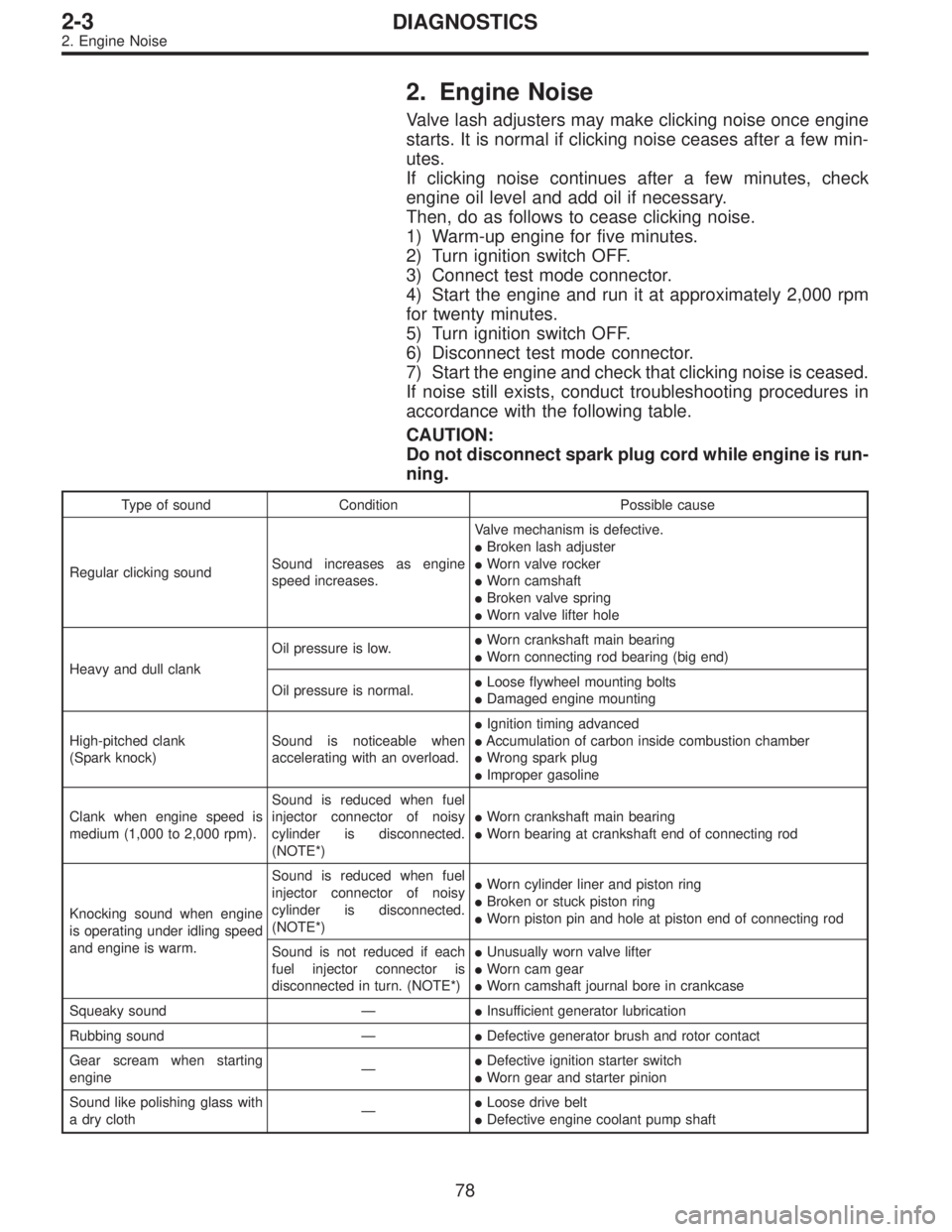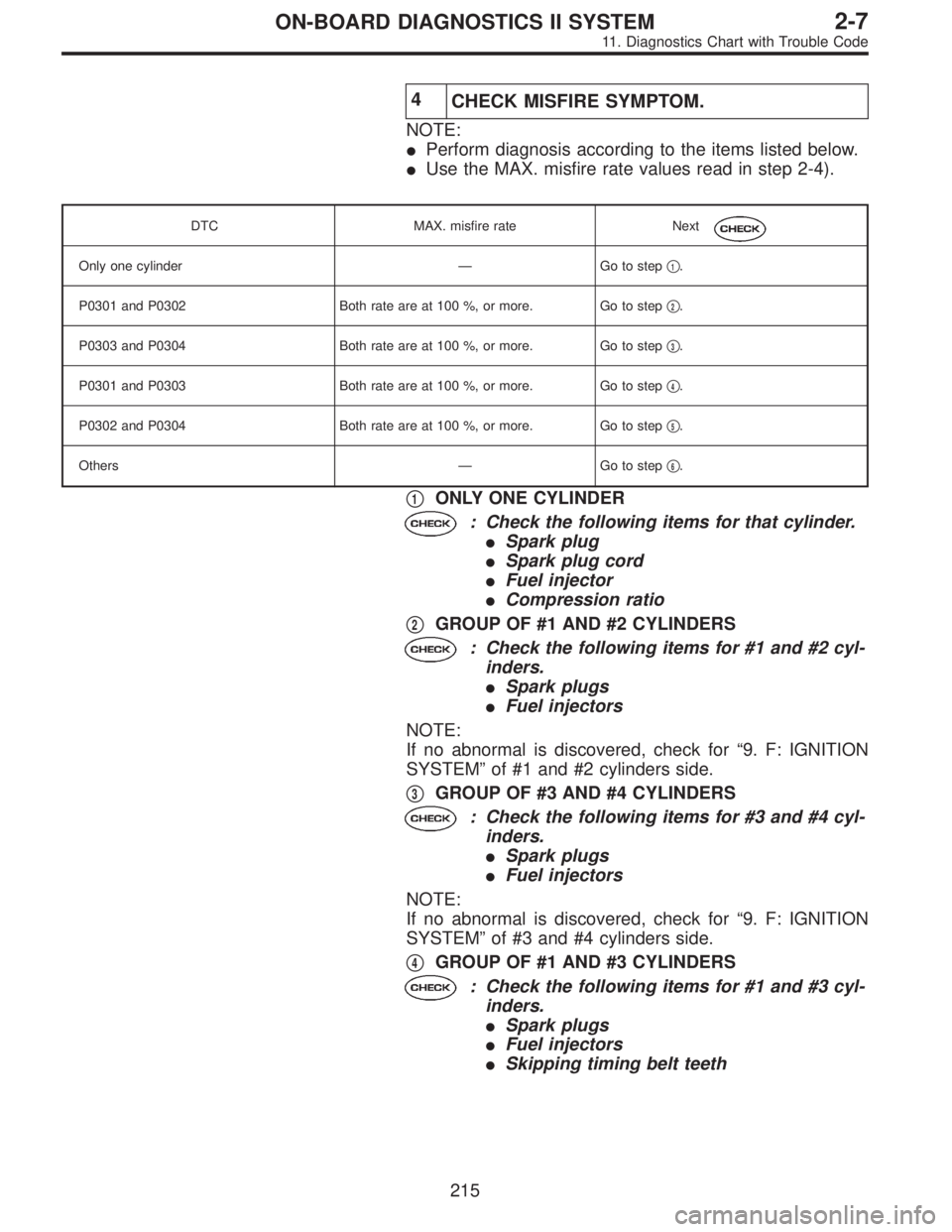Page 99 of 2248

2. Engine Noise
Valve lash adjusters may make clicking noise once engine
starts. It is normal if clicking noise ceases after a few min-
utes.
If clicking noise continues after a few minutes, check
engine oil level and add oil if necessary.
Then, do as follows to cease clicking noise.
1) Warm-up engine for five minutes.
2) Turn ignition switch OFF.
3) Connect test mode connector.
4) Start the engine and run it at approximately 2,000 rpm
for twenty minutes.
5) Turn ignition switch OFF.
6) Disconnect test mode connector.
7) Start the engine and check that clicking noise is ceased.
If noise still exists, conduct troubleshooting procedures in
accordance with the following table.
CAUTION:
Do not disconnect spark plug cord while engine is run-
ning.
Type of sound Condition Possible cause
Regular clicking soundSound increases as engine
speed increases.Valve mechanism is defective.
�Broken lash adjuster
�Worn valve rocker
�Worn camshaft
�Broken valve spring
�Worn valve lifter hole
Heavy and dull clankOil pressure is low.�Worn crankshaft main bearing
�Worn connecting rod bearing (big end)
Oil pressure is normal.�Loose flywheel mounting bolts
�Damaged engine mounting
High-pitched clank
(Spark knock)Sound is noticeable when
accelerating with an overload.�Ignition timing advanced
�Accumulation of carbon inside combustion chamber
�Wrong spark plug
�Improper gasoline
Clank when engine speed is
medium (1,000 to 2,000 rpm).Sound is reduced when fuel
injector connector of noisy
cylinder is disconnected.
(NOTE*)�Worn crankshaft main bearing
�Worn bearing at crankshaft end of connecting rod
Knocking sound when engine
is operating under idling speed
and engine is warm.Sound is reduced when fuel
injector connector of noisy
cylinder is disconnected.
(NOTE*)�Worn cylinder liner and piston ring
�Broken or stuck piston ring
�Worn piston pin and hole at piston end of connecting rod
Sound is not reduced if each
fuel injector connector is
disconnected in turn. (NOTE*)�Unusually worn valve lifter
�Worn cam gear
�Worn camshaft journal bore in crankcase
Squeaky sound—�Insufficient generator lubrication
Rubbing sound—�Defective generator brush and rotor contact
Gear scream when starting
engine—�Defective ignition starter switch
�Worn gear and starter pinion
Sound like polishing glass with
a dry cloth—�Loose drive belt
�Defective engine coolant pump shaft
78
2-3DIAGNOSTICS
2. Engine Noise
Page 100 of 2248
Type of sound Condition Possible cause
Hissing sound—�Loss of compression
�Air leakage in air intake system, hoses, connections or
manifolds
Timing belt noise—�Loose timing belt
�Belt contacting case/adjacent part
NOTE*:
When disconnecting fuel injector connector, Malfunction Indicator Light (CHECK ENGINE light) illuminates and trouble code is stored in
ECM memory.
Therefore, carry out the CLEAR MEMORY MODE and INSPECTION MODE after connecting fuel injector connector. (Ref. to 2-7 On-Board
Diagnostics II System.)
79
2-3DIAGNOSTICS
2. Engine Noise
Page 103 of 2248
G2M0066
1. Oil Pump
A: REMOVAL
1) Drain engine oil.
Set container under the vehicle, and remove drain plug
from oil pan.
B2M0051A
2) Drain coolant.
Set container under the vehicle, and remove drain cock
from radiator.
B2M0302
3) Remove belt covers, timing belt and related parts.
B2M0303
4) Remove belt tensioner bracket.
G2M0210
5) Remove left cam sprocket and left belt cover No. 2.
6) Remove water pump.
4
2-4SERVICE PROCEDURE
1. Oil Pump
Page 124 of 2248
B2M0302
7) Remove timing belt.
B2M0303
8) Remove belt tension adjuster.
G2M0417
9) Remove camshaft position sensor.
G2M0207
10) Remove left side camshaft pulley by using ST.
ST 499207100 CAMSHAFT SPROCKET WRENCH
G2M0208
11) Remove left side rear timing belt cover.
9
2-5SERVICE PROCEDURE
2. Engine Coolant Pump
Page 137 of 2248

1. Engine Cooling System
Trouble Possible cause Corrective action
Over-heatinga. Insufficient engine coolantReplenish engine coolant, inspect for leakage, and
repair.
b. Loose timing belt Repair or replace timing belt tensioner.
c. Oil on drive belt Replace.
d. Malfunction of thermostat Replace.
e. Malfunction of engine coolant pump Replace.
f. Clogged engine coolant passage Clean.
g. Improper ignition timingInspect and repair ignition control system.
h. Clogged or leaking radiator Clean or repair, or replace.
i. Improper engine oil in engine coolant Replace engine coolant.
j. Air/fuel mixture ratio too leanInspect and repair fuel injection system.
k. Excessive back pressure in exhaust system Clean or replace.
l. Insufficient clearance between piston and cylinder Adjust or replace.
m. Slipping clutch Repair or replace.
n. Dragging brake Adjust.
o. Improper transmission oil Replace.
p. Defective thermostat Replace.
q. Malfunction of electric fanInspect radiator fan relay, engine coolant temperature
sensor or radiator motor and replace there.
Over-coolinga. Atmospheric temperature extremely low Partly cover radiator front area.
b. Defective thermostat Replace.
Engine coolant
leaks.a. Loosened or damaged connecting units on hoses Repair or replace.
b. Leakage from engine coolant pump Replace.
c. Leakage from engine coolant pipe Repair or replace.
d. Leakage around cylinder head gasket Retighten cylinder head bolts or replace gasket.
e. Damaged or cracked cylinder head and crankcase Repair or replace.
f. Damaged or cracked thermostat case Repair or replace.
g. Leakage from radiator Repair or replace.
Noisea. Defective drive belt Replace.
b. Defective radiator fan Replace.
c. Defective engine coolant pump bearing Replace engine coolant pump.
d. Defective engine coolant pump mechanical seal Replace engine coolant pump.
19
2-5DIAGNOSTICS
1. Engine Cooling System
Page 1421 of 2248

4
CHECK MISFIRE SYMPTOM.
NOTE:
�Perform diagnosis according to the items listed below.
�Use the MAX. misfire rate values read in step 2-4).
DTC MAX. misfire rate Next
Only one cylinder—Go to step�1.
P0301 and P0302 Both rate are at 100 %, or more. Go to step�
2.
P0303 and P0304 Both rate are at 100 %, or more. Go to step�
3.
P0301 and P0303 Both rate are at 100 %, or more. Go to step�
4.
P0302 and P0304 Both rate are at 100 %, or more. Go to step�
5.
Others—Go to step�
6.
�1ONLY ONE CYLINDER
: Check the following items for that cylinder.
�Spark plug
�Spark plug cord
�Fuel injector
�Compression ratio
�
2GROUP OF #1 AND #2 CYLINDERS
: Check the following items for #1 and #2 cyl-
inders.
�Spark plugs
�Fuel injectors
NOTE:
If no abnormal is discovered, check for“9. F: IGNITION
SYSTEM”of #1 and #2 cylinders side.
�
3GROUP OF #3 AND #4 CYLINDERS
: Check the following items for #3 and #4 cyl-
inders.
�Spark plugs
�Fuel injectors
NOTE:
If no abnormal is discovered, check for“9. F: IGNITION
SYSTEM”of #3 and #4 cylinders side.
�
4GROUP OF #1 AND #3 CYLINDERS
: Check the following items for #1 and #3 cyl-
inders.
�Spark plugs
�Fuel injectors
�Skipping timing belt teeth
215
2-7ON-BOARD DIAGNOSTICS II SYSTEM
11. Diagnostics Chart with Trouble Code
Page 1422 of 2248
�5GROUP OF #2 AND #4 CYLINDERS
: Check the following items for #2 and #4 cyl-
inders.
�Spark plugs
�Fuel injectors
�Skipping timing belt teeth
�
6THE CYLINDER AT RANDOM
: Is the engine idle rough?
: Go to next. (AT models only)
: Go to DTC P0170 [T11P3], [T11P4] and [T11P5].
NOTE:
On MT models, go to DTC P0170 [T11P3], [T11P4] and
[T11P5].
OBD0631
OBD0632
: Is the differential pressure between maxi-
mum EGR system pressure (value of func-
tion mode F37) and minimum EGR system
pressure (value of function mode F38) less
than 10 mmHg?
NOTE:
Use the values read in step 3 for function modes F37 and
F38.
: Replace EGR valve.
: Go to DTC P0170 [T11P3], [T11P4] and [T11P5].
216
2-7ON-BOARD DIAGNOSTICS II SYSTEM
11. Diagnostics Chart with Trouble Code